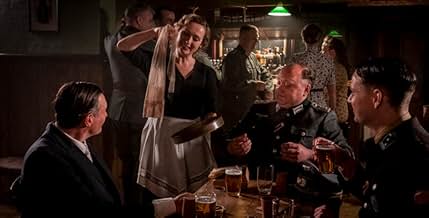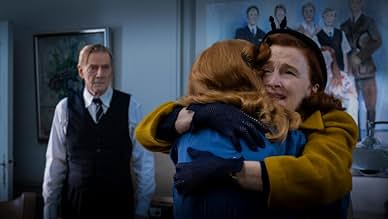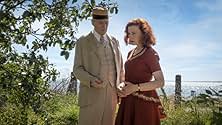Strong and dramatic sequel to "Into the Darkness" which follows the Skov family from 1943 to the end of WWII. The growing opposition to the occupation and the increased brutality of the Germ... Read allStrong and dramatic sequel to "Into the Darkness" which follows the Skov family from 1943 to the end of WWII. The growing opposition to the occupation and the increased brutality of the Germans have fatal consequences for the family.Strong and dramatic sequel to "Into the Darkness" which follows the Skov family from 1943 to the end of WWII. The growing opposition to the occupation and the increased brutality of the Germans have fatal consequences for the family.
- Director
- Writers
- Stars
- Awards
- 2 nominations total
- Director
- Writers
- All cast & crew
- Production, box office & more at IMDbPro
Featured reviews
De Forbandede År 2 is a Danish film directed by Anders Refn, which explores the various aspects of the occupation of Denmark during World War II. The film is a follow-up to the previous installment, De Forbandede År, and picks up in 1943, focusing on the Skov family, a wealthy Danish family deeply divided and confused. The film follows the family as they navigate the various challenges and complexities of the occupation, including collaboration with the Germans, resistance movements, and the impact of the war on Danish society.
The film offers an interesting follow-up to the characters introduced in the previous installment, exploring how their internal emotions change and how the oppressors become oppressed. The film is a nice bookend to the series, with powerful scenes that are both beautiful and engaging. The film features excellent performances from the cast, particularly Jesper Christensen and Bodil Jørgensen as the Skov family, and Mads Reuther as the conflicted antihero Aksel.
The film also offers a nuanced portrayal of the various aspects of the occupation, including the role of the Danish police as German collaborators, the cynical logic of collaborationist policies, and the important role played by communist resistance fighters. The film is a powerful depiction of the war and its impact on Danish society, and a welcome addition to the growing wave of resistance films in Danish cinema.
The film offers an interesting follow-up to the characters introduced in the previous installment, exploring how their internal emotions change and how the oppressors become oppressed. The film is a nice bookend to the series, with powerful scenes that are both beautiful and engaging. The film features excellent performances from the cast, particularly Jesper Christensen and Bodil Jørgensen as the Skov family, and Mads Reuther as the conflicted antihero Aksel.
The film also offers a nuanced portrayal of the various aspects of the occupation, including the role of the Danish police as German collaborators, the cynical logic of collaborationist policies, and the important role played by communist resistance fighters. The film is a powerful depiction of the war and its impact on Danish society, and a welcome addition to the growing wave of resistance films in Danish cinema.
The film stands as a visually compelling and ambitious portrayal of Denmark during the final years of World War II, focusing on the complexities of occupation, resistance, and collaboration. Director Anders Refn delivers a narrative that attempts to encapsulate the multifaceted experiences of a nation under duress, using the microcosm of a single family's journey to reflect broader societal tensions.
Cinematographically, the film excels in capturing the stark contrasts of the era-from the subdued interiors of Danish homes to the tension-filled streets under curfew. The attention to period detail in set design and costumes enhances the authenticity, immersing the audience in the 1940s setting. However, some scenes suffer from low lighting, making it challenging to discern the action, which may detract from the viewing experience.
Performances are a standout, particularly from the lead actors who convey the internal and external conflicts faced by their characters. The portrayal of moral ambiguity is central, as characters navigate the blurred lines between survival and betrayal. This nuanced depiction challenges the often black-and-white narratives of wartime cinema, offering a more complex view of human behavior under duress.
However, the film's ambition to encapsulate the entirety of Denmark's wartime experience through a single family's story leads to a densely packed narrative. The multitude of subplots-ranging from resistance activities to personal relationships-can at times overwhelm the central storyline, potentially diluting the emotional impact. Some sequences, while well-executed, may benefit from a more focused approach to maintain narrative cohesion.
In comparison to other World War II dramas that explore similar themes, this film distinguishes itself by delving into the less-explored aspects of Denmark's history, such as the role of the Danish police as collaborators and the complexities of the resistance movement. This perspective provides a fresh lens through which to examine the moral dilemmas faced by individuals during the occupation.
While the film's scope is ambitious, and its execution largely successful, the dense narrative and multitude of characters may challenge viewers seeking a more streamlined story. Nevertheless, its commitment to portraying the multifaceted nature of wartime experiences makes it a significant contribution to the genre, offering a thought-provoking exploration of a nation's struggle with its past.
Cinematographically, the film excels in capturing the stark contrasts of the era-from the subdued interiors of Danish homes to the tension-filled streets under curfew. The attention to period detail in set design and costumes enhances the authenticity, immersing the audience in the 1940s setting. However, some scenes suffer from low lighting, making it challenging to discern the action, which may detract from the viewing experience.
Performances are a standout, particularly from the lead actors who convey the internal and external conflicts faced by their characters. The portrayal of moral ambiguity is central, as characters navigate the blurred lines between survival and betrayal. This nuanced depiction challenges the often black-and-white narratives of wartime cinema, offering a more complex view of human behavior under duress.
However, the film's ambition to encapsulate the entirety of Denmark's wartime experience through a single family's story leads to a densely packed narrative. The multitude of subplots-ranging from resistance activities to personal relationships-can at times overwhelm the central storyline, potentially diluting the emotional impact. Some sequences, while well-executed, may benefit from a more focused approach to maintain narrative cohesion.
In comparison to other World War II dramas that explore similar themes, this film distinguishes itself by delving into the less-explored aspects of Denmark's history, such as the role of the Danish police as collaborators and the complexities of the resistance movement. This perspective provides a fresh lens through which to examine the moral dilemmas faced by individuals during the occupation.
While the film's scope is ambitious, and its execution largely successful, the dense narrative and multitude of characters may challenge viewers seeking a more streamlined story. Nevertheless, its commitment to portraying the multifaceted nature of wartime experiences makes it a significant contribution to the genre, offering a thought-provoking exploration of a nation's struggle with its past.
I prefer when movies don't insult my intelligence. In this character-driven world war two drama, many things are only implied, which is great. An example: in a short scene a mother and her son want to escape by boat from Denmark to neutral Sweden. We are not told why and we don't know anything about them, but if you know your history, you will be able to fill in the blanks.
But this also presents a dilemma. Not only is this movie the second part of a family saga, so you need to watch the first one in order to get a grasp about what is going on and the who's who. But if you don't know anything about the years of the nazi occupation in Denmark, this could be a tough watch.
By far the strongest points are the moral conflicts and dilemmas that all the characters face. Who can you trust? Where is your loyality? Great stuff here.
But this also presents a dilemma. Not only is this movie the second part of a family saga, so you need to watch the first one in order to get a grasp about what is going on and the who's who. But if you don't know anything about the years of the nazi occupation in Denmark, this could be a tough watch.
By far the strongest points are the moral conflicts and dilemmas that all the characters face. Who can you trust? Where is your loyality? Great stuff here.
Did you know
- TriviaIn Memoriam: Flemming Quist Møller (1942-2022)
- ConnectionsFollows De forbandede år (2020)
- How long is Out of the Darkness?Powered by Alexa
Details
- Release date
- Country of origin
- Language
- Also known as
- Out of the Darkness
- Production company
- See more company credits at IMDbPro
- Runtime2 hours 32 minutes
- Color
Contribute to this page
Suggest an edit or add missing content

































